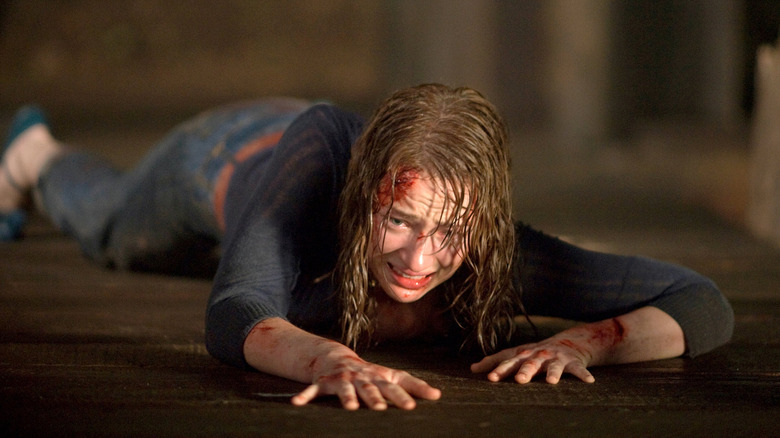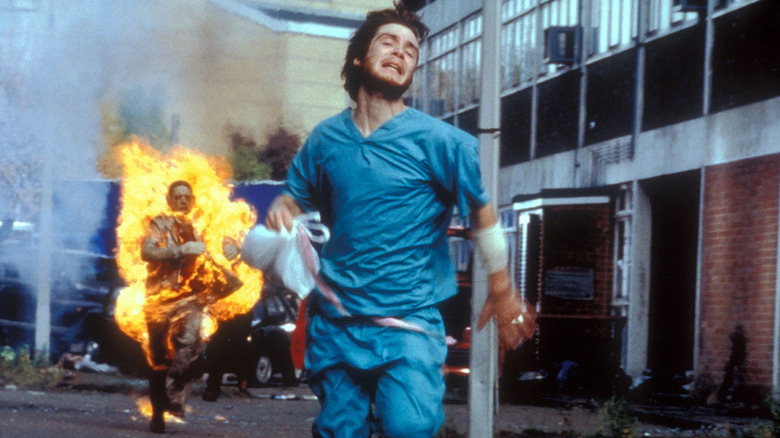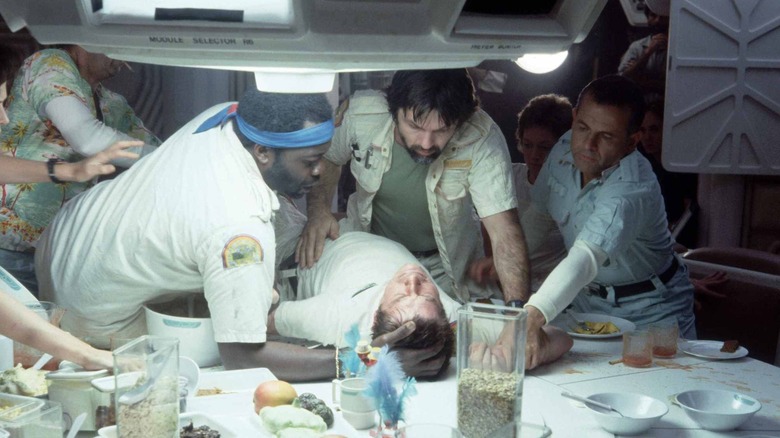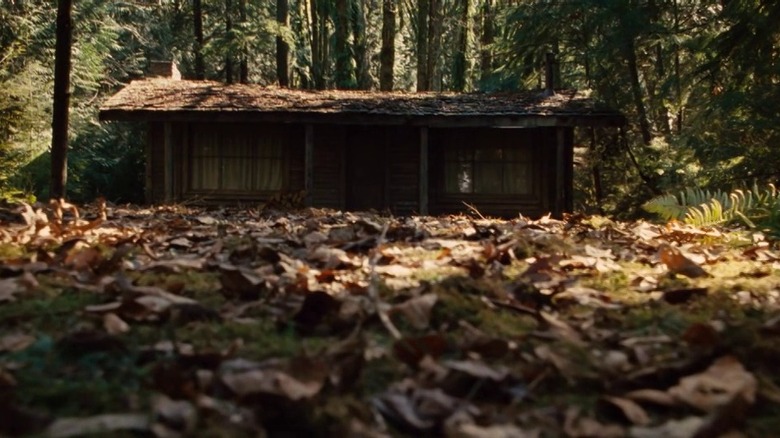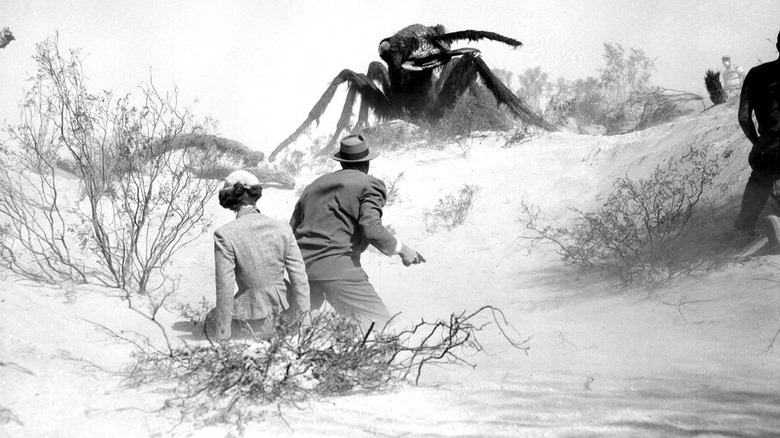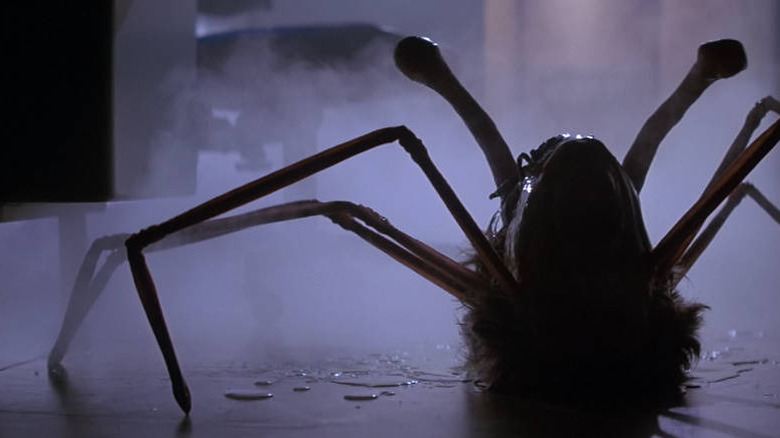Sci-Fi Horror Movies The Average Person Would Never Survive
Sometimes, the victims in horror movies get what's comin' to 'em: maybe they take unnecessary risks, test fate, or just otherwise make poor, life-costing decisions. Other times, however, they were goners from the start — and there was nothing they could do to avoid their fate.
There are some truly terrifying sci-fi horror movies that leave even seasoned genre-fans feeling disturbed, and it's not always about gore or violence. Part of horror's appeal is picturing yourself in those circumstances and trying to imagine how you would react to the situation. So when a story places a cast of unsuspecting normal people in extreme situations with no obvious solution, it's natural to feel a little freaked out.
The scariest science-fiction movies are the ones that no average person could reasonably expect to survive. These are films where the characters struggle against unsurmountable odds: maybe they are trapped on a spaceship with an ultra-contagious virus, or it could be an apocalyptic-level event expected to wipe out all life on Earth. Whether the threat is a seemingly unstoppable alien monster or a global catastrophe there's no escape from, the average Joe's outcome does not look good.
Of course, in many of these movies, the heroes save the day in the end — maybe by killing the big baddie or somehow preventing the apocalypse at the very last minute. But some dangers are more devastating than others — like these six sci-fi horror movies that the average person would never survive.
28 Days Later
Zombies are often found in horror, post-apocalyptic, and even fantasy settings, and for good reason: there's something uniquely compelling — and repulsive — about the basic idea or mindless, rotting, walking human corpses.
Of all the zombie stories, however, Danny Boyle's "28 Days Later" is one of the most disturbing. Moving away from the supernatural element found in horror films like "Night of the Living Dead," "28 Days Later" presents a grittier and more realistic premise: This apocalypse is the result of an epidemic. The blood-borne "Rage" virus is a highly contagious pathogen that turns the average, mild-mannered citizen into a vacuous, unthinking being singularly motivated to do violence. Those who are infected have no hope of recovery. They act as though they feel no pain and have no instincts for self-preservation. They are, effectively, already dead.
In "28 Days Later," and the sequel "28 Weeks Later," most people become infected and/or die almost immediately. If the coronavirus pandemic proved anything, it's that it's very, very hard to not catch highly contagious viruses — and that's without angry people trying to vomit their infectious blood all over you. Forget week-long quarantines — the few who did survive the initial outbreak in "28 Days Later" can't really leave their homes ever without risking their lives. The protagonist and other survivors initially avoided the virus by dumb luck, but that good fortune has run out. And if that's not bad enough, those in the outbreak area also have to contend with trigger-happy military all too ready to put a bullet in anyone's head. Forget mask mandates and social distancing; this is a world where simply stepping outside can be fatal.
Alien
Even after 40 years, Ridley Scott's "Alien" is pure sci-fi terror. The movie launched a massive franchise, which includes James Cameron's "Aliens," the prequel "Prometheus," and even the crossover "Alien vs. Predator." And with each new entry, the core story expanded, developing a more action-oriented tone. But where it all started — "Alien" — well, that's pure, good old fashioned, classic sci-fi horror.
From "Alien: Resurrection" onward, it's abundantly clear that the best way to deal with a Xenomorph is to not deal with the Xenomorph and run like hell. Sure, Ripley manages to survive multiple encounters (sort of), but she's the exception to the rule. The second that facehugger hatches, you and everyone around you is doomed. Even in "Aliens," Ripley basically says as much; the only reason this species keeps being a problem is because of the Weyland-Yutani Corporation's insane plan to weaponize the Xenomorphs. It's exactly the kind of dumb, capitalist agenda that seems just corrupt enough to be believable.
In the first "Alien" movie, there is no hope of survival for anyone. Being trapped on a terraforming colony or a prison planet is bad enough, but at least then there's the chance that some people could recognize the red flags and flee. Oh, people are disappearing? Hmm, there's some strange acid burning through the floors? What's that you say — you found some hatched dragon eggs covered in snot? Time to get the hell out of Dodge.
But "Alien" is more like a haunted house story set on a spaceship. The crew doesn't really understand what they're up against until it's too late and the Nostromo is already compromised. They are trapped in space with an alien monster that wants to murder them. No average person is surviving that situation.
The Cabin in the Woods
Drew Goddard's subversive horror-comedy "The Cabin in the Woods" begins with a classic, slasher premise, but as the story unfolds, a more sinister — and distinctly sci-fi — plot emerges. College students Dana, Curt, Jules, Marty, and Holden are all spending the weekend in a remote cabin in the woods (hence the movie's title). Little do they know, this is no normal vacation property. It's been outfitted with surveillance equipment that allows mysterious men in a control room to monitor the teens' every move. Drugs are pumped into the air to cloud the kids' judgment, and innocuous-looking but extremely dangerous objects are displayed in the basement, ready to be activated by the unsuspecting teenagers.
Unbeknownst to the soon-to-be victims, they have waltzed into a trap, designed to offer human sacrifices to powerful deities known as the "Ancient Ones." There's a distinctly science-fiction lean to the story, thanks to the reliance on technology and the general aesthetic used for the laboratory design. But the ritual scenarios seen in "The Cabin in the Woods" are all the best horror movie tropes: zombies, werewolves, and even a monster inspired by the "Hellraiser" series, "Fornicus, Lord of Bondage and Pain."
The resulting mix is a sci-fi horror premise that only the luckiest and most resilient people could hope to live through: The odds are definitely stacked against the sacrificial teens, who not only have to fight against whatever antagonist they unleash, but also the mind-altering drugs, pheromones, and hidden forcefields. Yikes.
Predator
In the '80s, Arnold Schwarzenegger was one of the biggest action stars in Hollywood. He was known for his roles in films like "Commando" and "Raw Deal," which saw the actor play tough, gun-wielding good guys who know how to get stuff done. Then came 1987's "Predator," which flips the script halfway through. What starts as a typical action-movie set up — an elite, specially trained combat unit rescuing hostages from enemy forces — turns into a cat-and-mouse game deep in the Central American rainforest with a terrifying, invisible alien. The ultra-masculine crew may have been prepared to face the toughest guerilla-fighters on the planet, but they were totally unprepared for something not of this world.
Surviving "Predator" means surviving the Predator, which is downright impossible for 99% of people. The alien's entire raison d'être is to be the best hunter in the universe. It has superior technology, superior weaponry, and superior athleticism — not to mention a "very particular set of skills" (to borrow a phrase from "Taken"). Schwarzenegger's character Dutch may have concluded "if it bleeds, we can kill it," but the average person wouldn't have lasted long enough to figure that out.
Them!
There's something almost quaint about the old '50s sci-fi horror films that imagine nuclear power and science gone wrong, creating unimaginable monstrosities. This is the decade that brought us hits like "Godzilla," "The Mole People," and "It Came From Beneath the Sea." In most of these films, there's one giant monster or one particular location that's dangerous; sure, if you're caught off-guard by a rampaging kaiju, or accidentally wander into a secret, underground society, things are probably not going to end well. At the same time though, the threat feels limited in scope.
This, however, is not the case for "Them!" — a 1954 monster movie about giant, irradiated ants.
The ants in "Them!" are easily the scariest of the "big bug" movie monsters from this time period. Not only are they convincingly threatening, thanks to some pretty decent practical effects, but the concept itself is terrifying. Deep underground, the queens establish nests that have the power to overwhelm the human population on the surface. These things are massive, yet are travelling in tunnels underfoot, undetected, and ready to spring up at any moment, grabbing unsuspecting victims in their vice-like mandibles. You can run, and you can hide, but can you escape from ... THEM!?
The Thing
If there's any experience that no one is waking away from, it's being trapped in Antartica with a shapeshifting, impossible-to-kill parasitic alien that wants to assimilate you. In the 1951 film "The Thing from Another World," a team of U.S. Air Force crew and scientists discover a humanoid alien frozen in the Arctic ice. After they bring it back to base for study, it escapes custody and starts hunting people down. While this premise is already threatening, John Carpenter really kicked it up a notch with his 1982 remake, simply titled "The Thing."
As the unlucky researchers in a remote Antarctic station discover, the parasitic alien in Carpenter's film can disguise itself as your peers, pals, and even pets. Everything seems normal until suddenly, the body mutates into something hideous and very, very dangerous. This results in an atmosphere of paranoia, which only escalates the present danger. The alien imitates other species' anatomy so well that even the internal organs appear normal.
If one does figure out a test for detecting the Thing, like Kurt Russell's MacReady does, there's still the enormous challenge of somehow finding and destroying every last ounce of the lifeform, lest it get to you first. Survival is unlikely, and escape is impossible. No one gets to walk away from "The Thing."
